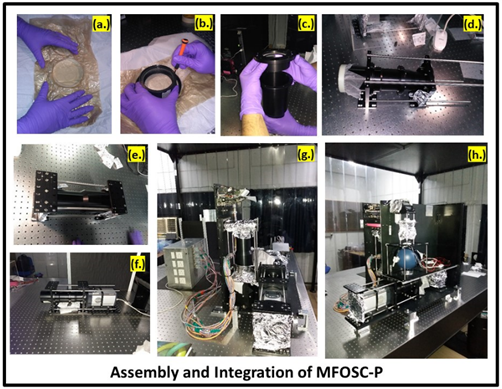
MFOSC-P एक नया डिजाइन और लागत-प्रभावी तरीका प्रस्तुत करता है, जो FOSC (फेंट ऑब्जेक्ट स्पेक्ट्रोग्राफ और कैमरा) प्रकार के उपकरण को कम समय-सीमा में विकसित करने में सक्षम बनाता है। इसका डिज़ाइन और विकास विधि विशेष रूप से छोटे एपर्चर टेलीस्कोप के लिए उपयुक्त है। MFOSC-P के डिजाइन और अन्य विशेषताओं पर चर्चा निम्नलिखित संदर्भ में की गई है:
“Design and development of Mt.Abu faint object spectrograph and camera – Pathfinder (MFOSC-P) for PRL 1.2m Mt. Abu Telescope”,
Srivastava et al., 2021, Experimental Astronomy, volume 51, pages345–382"
https://link.springer.com/article/10.1007/s10686-021-09753-5
उपकरण डिज़ाइन विशेषताएँ
(from Srivastava et al. 2021, Experimental Astronomy, volume 51, pages345–382 ( https://link.springer.com/article/10.1007/s10686-021-09753-5 ))
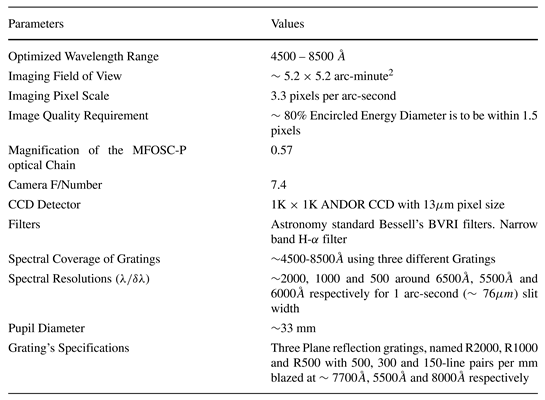
स्पेक्ट्रोस्कोपी के लिए ग्रेटिंग्स विनिर्देश
(from Srivastava et al. 2021, Experimental Astronomy, volume 51, pages345–382 ( https://link.springer.com/article/10.1007/s10686-021-09753-5 ))
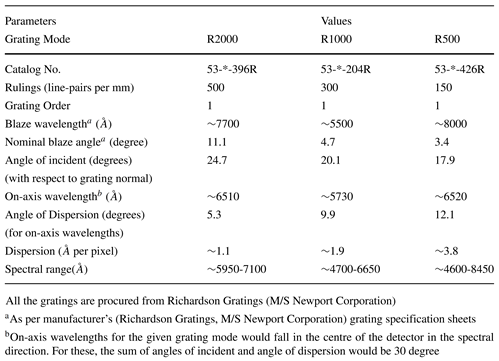
अंशांकन लैंप स्पेक्ट्रोस्कोपी से उत्सर्जन रेखा प्रोफाइल
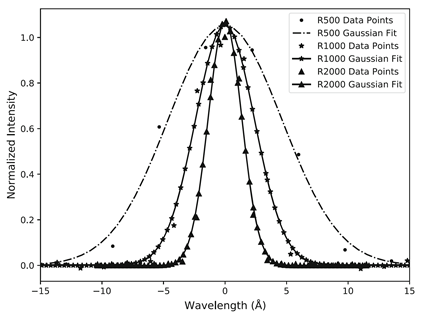
चित्र 1: चित्र में MFOSC-P के सभी तीन स्पेक्ट्रोस्कोपी मोड्स के लिए ज़ेनन और नीयन स्पेक्ट्रल अंशांकन लैंप के लिए रेखा प्रोफाइल दर्शाए गए हैं, जिसमें 75 माइक्रोन का स्लिट (~1 आर्क-सेकंड आसमान पर)। केंद्रीय शून्य तरंगदैर्ध्य ज़ेनन लैंप के 7119 एंग्स्ट्रॉम रेखा से संबंधित है, जो R500 (150 lp/mm) ग्रेटिंग का उपयोग करता है (बिंदु), ज़ेनन लैंप के 5028 एंग्स्ट्रॉम रेखा के लिए R1000 (300 lp/mm) ग्रेटिंग का उपयोग (तारे), और नीयन लैंप के 6506 एंग्स्ट्रॉम रेखा के लिए R2000 (500 lp/mm) ग्रेटिंग का उपयोग (त्रिकोण)। इन रेखाओं के लिए गॉसियन फिट्स ∼3 पिक्सल FWHM में परिणाम देते हैं, जो क्रमशः R500, R1000 और R2000 मोड्स के लिए 10.9, 5.7 और 3.2 एंग्स्ट्रॉम के बराबर होते हैं। यह चित्र Srivastava et al., 2021, Experimental Astronomy, volume 51, pages345–382 से पुन: प्रस्तुत किया गया है।
MFOSC-P पर आसमान पर T CrB का स्पेक्ट्रा - एक सहजीवी प्रणाली
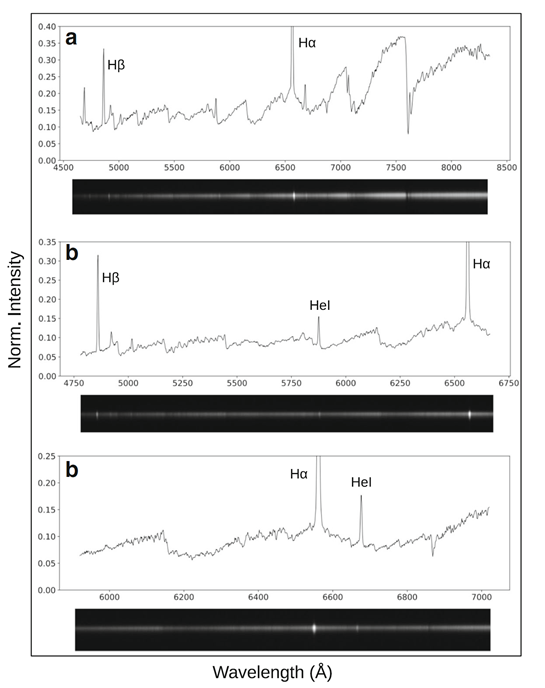
चित्र 2: सहजीवी प्रणाली - T CrB का स्पेक्ट्रा, जो MFOSC-P से उसके तीन स्पेक्ट्रोस्कोपी मोड्स से विभिन्न रिज़ॉल्यूशंस और स्पेक्ट्रल रेंज के लिए प्राप्त किया गया है।
MFOSC-P से स्पेक्ट्रोस्कोपी के लिए प्राप्त SNR

चित्र 3: MFOSC-P स्पेक्ट्रा से सिमुलेटेड सिग्नल-टू-नॉइज़ अनुपात (SNR) की तुलना अवलोकित डेटा से। मॉडल 2.0 आर्क-सेकंड FWHM देखने और 1.0 आर्क-सेकंड स्लिट चौड़ाई का अनुमान लगाता है। यह चित्र श्रीवास्तव एट अल., 2021, Experimental Astronomy, खंड 51, पृष्ठ 345–382 से पुन: प्रस्तुत किया गया है।
MFOSC-P on-Sky imaging
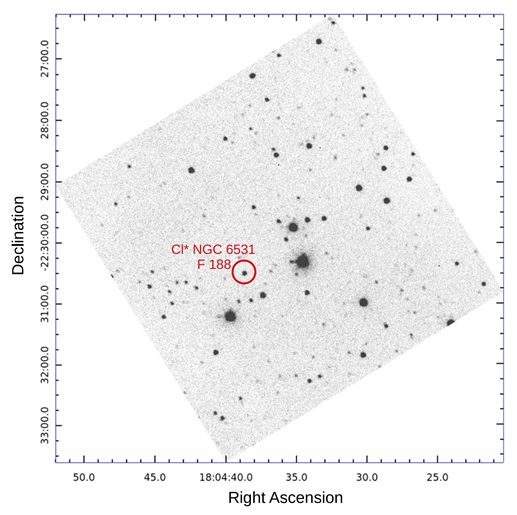
चित्र 4: MFOSC-P से M21 ओपन क्लस्टर के एक क्षेत्र का V बैंड चित्र। V परिमाण ∼15.74 (घेरा बनाया गया) का एक स्रोत 40 सेकंड के समाकलन समय में 0.15 परिमाण (SNR∼7.3) की त्रुटि के साथ देखा गया है। यह चित्र श्रीवास्तव एट अल., 2021, Experimental Astronomy, खंड 51, पृष्ठ 345–382 से पुन: प्रस्तुत किया गया है।
MFOSC-P से प्रकाशन
संदर्भित प्रकाशन
- “A phenomenological study of the evolution of shock-induced O I emission lines in the spectrum of nova V2891 Cygni ”, Pandey et al., 2024, MNRAS, 532, 4, 3985-4001 (DOI: https://doi.org/10.1093/mnras/stae1719)
- “Intra-night optical variability of peculiar narrow-line Seyfert 1 galaxies with enigmatic jet behaviour”, Ojha et al., 2024, MNRAS: Letters, 529, 1, L108–L114 (DOI: https://doi.org/10.1093/mnrasl/slae003)
- “Exploring the short-term variability of H α and H β emissions in a sample of M dwarfs”, Kumar et al., 2023, MNRAS, 524, 4, 6085–6101 (DOI: https://doi.org/10.1093/mnras/stad2222)
- “Optical and X-ray studies of Be/X-ray binary 1A 0535+262 during its 2020 giant outburst”, Chhotaray et al., 2023, MNRAS, 518, 4, 5089–5105 (DOI: https://doi.org/10.1093/mnras/stac3354)
- "Optical and near-infrared spectroscopy of Nova V2891 Cygni: Evidence for shock-induced dust formation", Kumar et al,2022, MNRAS, 510, 3, 2022, 4265-4283 (DOI: https://doi.org/10.1093/mnras/stab3772)
- “The Flare-Activity of 2MASSJ16111534-1757214 in the Upper Scorpius association”, Guenther et al, 2021, MNRAS, 507, 2, 2103–2114 (DOI: https://doi.org/10.1093/mnras/stab1973)
- “Design and development of Mt.Abu faint object spectrograph and camera - Pathfinder (MFOSC-P) for PRL 1.2m Mt. Abu Telescope”, Srivastava et al., 2021, Experimental Astronomy, 51, 345–382 (DOI: https://doi.org/10.1007/s10686-021-09753-5)
- “UV spectroscopy confirms SU Lyn to be a symbiotic star”, Kumar et al., 2021, MNRAS:Letters, 500,1, L12-L16 (DOI: https://doi.org/10.1093/mnrasl/slaa159)
- “First results from MFOSC-P: low-resolution optical spectroscopy of a sample of M dwarfs within 100 parsecs”, Rajpurohit et al., 2020, MNRAS,492,4,5844-5852 (DOI: https://doi.org/10.1093/mnras/staa163)
सम्मेलन कार्यवृत्त
- “Optical Spectroscopy of 1A 0535+262 Before, During, and After the 2020 Giant X-ray Outburst”, Naik et al., 2024, Volume 93 - Année 2024 — No 2 - Proceeedings of the 3rd BINA Workshop on the Scientific Potential of the Indo-Belgian Cooperation (DOI: https://doi.org/10.25518/0037-9565.11829)
- “Exploring the short-term variability of H-alpha and H-beta emissions in a sample of M Dwarfs”, Kumar et al., 2022, Proceedings of the 21st Cambridge Workshop on Cool Stars, Stellar Systems, and the Sun (CS21), Toulouse, France, 04-08 July 2022, Edited By Edited by A. S. Brun, J. Bouvier, P. Petit (DOI: https://doi.org/10.5281/zenodo.7588979)
- “Design and development of Mt. Abu faint object spectrograph and camera-pathfinder (MFOSC-P) for PRL 1.2m Mt. Abu telescope, India”, Srivastava et al., 2018, Ground-based and Airborne Instrumentation for Astronomy VII. Proceedings of the SPIE, 107024I (DOI: https://doi.org/10.1117/12.2309306)